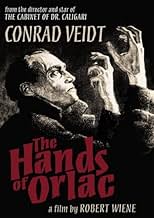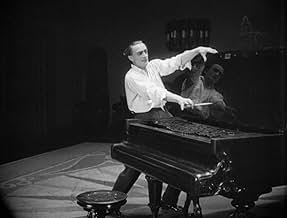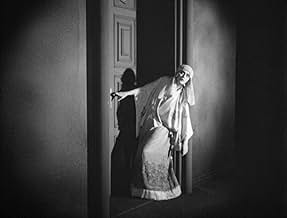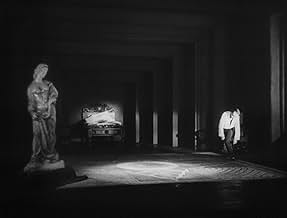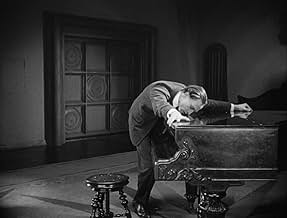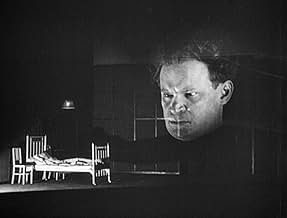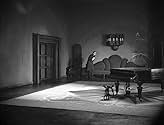IMDb-BEWERTUNG
7,0/10
3680
IHRE BEWERTUNG
Ein weltberühmter Pianist verliert bei einem Unfall beide Hände. Wenn neue Hände verpflanzt werden, weiß er nicht, dass sie einmal einem Mörder gehörten.Ein weltberühmter Pianist verliert bei einem Unfall beide Hände. Wenn neue Hände verpflanzt werden, weiß er nicht, dass sie einmal einem Mörder gehörten.Ein weltberühmter Pianist verliert bei einem Unfall beide Hände. Wenn neue Hände verpflanzt werden, weiß er nicht, dass sie einmal einem Mörder gehörten.
- Regie
- Drehbuch
- Hauptbesetzung
Conrad Veidt
- Paul Orlac
- (as Veidt)
Alexandra Sorina
- Yvonne Orlac
- (as Sorina)
Fritz Strassny
- Der alte Orlac
- (as Strassny)
Paul Askonas
- Der Diener
- (as Askonas)
Carmen Cartellieri
- Regine
- (as Cartellieri)
Hans Homma
- Dr. Serral
- (as Homma)
Fritz Kortner
- Nera
- (as Kortner)
Empfohlene Bewertungen
I've been looking for a DVD of THE HANDS OF ORLAC ever since I knew the film existed. Now it's finally here, and like most silent films it's a mixed bag. I find the image on the new KINO disc to be acceptable considering the problematic nature of the source material. There's a loss of definition in some scenes, but there are also moments of sharpness in the restored Murnau Foundation print. It's a shame we can never experience non-talking films the way 1920s audiences did, without washed-out contrasts, image-flickers, frame-jitters, dirt, and print damage. Even the best restorations don't look new.
The plot concerns a concert pianist whose hands are smashed in a train wreck. A surgeon replaces them with the hands an executed criminal. Soon the pianist is obsessed with thoughts he might be a killer. The performances are generally excellent in the Expressionistic style. Conrad Veidt's exaggerated grimacing as his character Paul Orlac approaches madness is tempered by moments that are extremely moving.
The score of mostly string music on the KINO disc is creepy and works well for a while, but is so monotonous over the entire length of an already ponderously paced film that I grew tired of it. This film cries out for music that varies its mood to fit what is happening on screen. Contrasts in the mood of the music would make the creepy parts seem even creepier. An optional score in a traditional style would have been nice. Nevertheless, the Gothic set design and shadow-infested cinematography by Gunther Krampf - particularly the scenes at Orlac's father's house - create the atmosphere we know and love in early horror films. These chiaroscuro light-and-shadow effects just cannot be achieved with color.
However, to evoke fear without the modern cheats of gore and violence - to create what the Germans call "stimmung" (mood) - requires not only imaginative lighting and set design, but time. Unfortunately director Robert Weine spends too much time on the actors' very deliberate expressionistic movements at the expense of pacing.
The ending is likewise unsatisfactory, although it does follow Maurice Renard's novel. I won't give too much away other than to say the ending undercuts an apparently fantastic element, yet makes the "logical" explanation seem almost as implausible. Nevertheless, the build-up to the resolution as well as Veidt's engrossing performance makes this a worthwhile, if uninspired, film.
The plot concerns a concert pianist whose hands are smashed in a train wreck. A surgeon replaces them with the hands an executed criminal. Soon the pianist is obsessed with thoughts he might be a killer. The performances are generally excellent in the Expressionistic style. Conrad Veidt's exaggerated grimacing as his character Paul Orlac approaches madness is tempered by moments that are extremely moving.
The score of mostly string music on the KINO disc is creepy and works well for a while, but is so monotonous over the entire length of an already ponderously paced film that I grew tired of it. This film cries out for music that varies its mood to fit what is happening on screen. Contrasts in the mood of the music would make the creepy parts seem even creepier. An optional score in a traditional style would have been nice. Nevertheless, the Gothic set design and shadow-infested cinematography by Gunther Krampf - particularly the scenes at Orlac's father's house - create the atmosphere we know and love in early horror films. These chiaroscuro light-and-shadow effects just cannot be achieved with color.
However, to evoke fear without the modern cheats of gore and violence - to create what the Germans call "stimmung" (mood) - requires not only imaginative lighting and set design, but time. Unfortunately director Robert Weine spends too much time on the actors' very deliberate expressionistic movements at the expense of pacing.
The ending is likewise unsatisfactory, although it does follow Maurice Renard's novel. I won't give too much away other than to say the ending undercuts an apparently fantastic element, yet makes the "logical" explanation seem almost as implausible. Nevertheless, the build-up to the resolution as well as Veidt's engrossing performance makes this a worthwhile, if uninspired, film.
Flirting with a (then) science fictional theme of body part transplantation, the film explores the feelings of a concert pianist, who having lost his hands in a train wreck, receives a new pair of hands that belonged to an executed murderer. Austrian director Robert Weine, who created the landmark 'The Cabinet of Dr. Caligari' (1919) here reunites with and directs its star, Conrad Veidt, as the tormented pianist Paul Orlac.
The camera focuses on Veidt's many moods and reactions to his plight -- his hands are not capable of his concert abilities, and he feels that they are taking him over with thoughts and deeds of crime and murder. He does an outstanding job, but too much of the film is slowly paced. From the beginning extended train crash rescue, on through scene after scene of Orlac's, his wife's and the maid's over the top Expressionistic gesturing, the scenes seem to go on too long.
This slow pace is exaggerated by the lack of camera movement (everything is mostly wide shots with little tracking), the wonderfully and effectively spooky new musical score (on the KINO 2008 version), that sometimes lacks verve and variety, as well as the extensive time spent on the actors' Expressionist movements.
The film certainly has its high points. It's great to see an entire film shot in shadows and low light, all with Gothic sets. This is great German Expressionism. If you can relax and just go with the pace of the film, you can really enjoy the acting of Conrad Veidt-- whose hands keep getting creepier and scarier.
If it were cut to about sixty minutes to pick up the pace, it would be easier to enjoy and to see the great care that went into its creation and execution.
I'll have to give it a six.
The camera focuses on Veidt's many moods and reactions to his plight -- his hands are not capable of his concert abilities, and he feels that they are taking him over with thoughts and deeds of crime and murder. He does an outstanding job, but too much of the film is slowly paced. From the beginning extended train crash rescue, on through scene after scene of Orlac's, his wife's and the maid's over the top Expressionistic gesturing, the scenes seem to go on too long.
This slow pace is exaggerated by the lack of camera movement (everything is mostly wide shots with little tracking), the wonderfully and effectively spooky new musical score (on the KINO 2008 version), that sometimes lacks verve and variety, as well as the extensive time spent on the actors' Expressionist movements.
The film certainly has its high points. It's great to see an entire film shot in shadows and low light, all with Gothic sets. This is great German Expressionism. If you can relax and just go with the pace of the film, you can really enjoy the acting of Conrad Veidt-- whose hands keep getting creepier and scarier.
If it were cut to about sixty minutes to pick up the pace, it would be easier to enjoy and to see the great care that went into its creation and execution.
I'll have to give it a six.
Director Robert Wiene and star Conrad Veidt reteam for this Austrian horror suspense drama. Veidt plays Paul Orlac, a famous concert pianist who gets severely injured in a train crash. Dr. Serral (Hans Homma) tries an experimental technique wherein he grafts the hands of a dead man onto Orlac's arms, and the surgery is a success, but afterward, when Orlac learns that the hands belonged to an executed murderer, he starts to lose his mind, believing that the hands are commanding him to kill again. Also featuring Alexandra Sorina, Fritz Strassny, Paul Askonas, Carmen Cartellieri, and Fritz Kortner.
Wiene continues to use Expressionistic techniques and visual schemes, but they are toned down, and used to accentuate the narrative rather than overwhelming the proceedings. The film marks an important step in the transition from purely arthouse Expressionism to the techniques used in the visual language of film noir. Veidt gives an intense, tortured performance, although Kortner pales in comparison to the later remake Mad Love and Peter Lorre's take on the character. Most sources list this as being roughly 90 minutes, but the version I watched was 113 minutes. I felt that could have been trimmed down a bit, as some scenes dragged. That being said, I enjoyed the film quite a bit, and the cinematography was beautiful.
Wiene continues to use Expressionistic techniques and visual schemes, but they are toned down, and used to accentuate the narrative rather than overwhelming the proceedings. The film marks an important step in the transition from purely arthouse Expressionism to the techniques used in the visual language of film noir. Veidt gives an intense, tortured performance, although Kortner pales in comparison to the later remake Mad Love and Peter Lorre's take on the character. Most sources list this as being roughly 90 minutes, but the version I watched was 113 minutes. I felt that could have been trimmed down a bit, as some scenes dragged. That being said, I enjoyed the film quite a bit, and the cinematography was beautiful.
Ah, what aristocratic days are these!!... These modern times of the new 21st century have many similarities to the old youthful times that Herr Graf spent in Deutschland at the beginning of the ancient 20th century; that is to say, during those days the world had a tremendous financial crisis not to mention the menace of a world flu pandemic. It seemed appropriate then that Herr Von decided to revisit those memories by watching at the Schloss theatre a strange, oppressive film, a picture that reflected those times and the aristocratic mood. A perfect soirée, indeed!... The film was "Orlacs Hände" (1924) by Herr Robert Wiene.
It was a pleasure ( you have to know that German aristocrats have fun in a different and dark way .. ) to watch again such a classic Expressionist masterpiece. Thanks are owed to the longhaired youngsters at Kino who did an excellent restoration of this old nitrate which includes a bearable music score by Herr Paul Mercer that helps one to suppress the memory of the terrible score that was included some time ago in another release of the film; that music was scarier than the film itself.
Even today, to watch "Orlacs Hände" is a disturbing experience aside from appreciating its Expressionist values. Early in the film, the train crash sequence is full of dark and impressive shots that capture the confusion, warning the audience that this is a special oeuvre. It bespeaks a terrible chaos, uncertainty and darkness that engulfs the viewer in an oppressive, tormented atmosphere.
Due to the train crash, Herr Orlac ( Herr Conrad Veidt ) our hero will suffer horrible wounds to body and soul. The physical scars heal up but the psychological wounds are more difficult to overcome, especially when Herr Orlac discovers that his new hands belonged to an assassin. This marks the beginning of a terrible "tour de force" between body and soul that will torment Herr Orlac throughout the film. His fragility is challenged by pain and suffering and though solace and calm ultimately prevail he must first face constant uncertainty, delirium and the threat of insanity.
The Expressionist shadows, appropriately enough, surround the main characters ( The performances by the great Herr Veidt and Dame Alexandra Sorina are also in the Expressionist manner ) and their habitats; their home, at the hospital, and in the streets. An oppressive, morbid, gloomy atmosphere prevails and suits perfectly a story of wicked impulses and disturbed minds.
Hands demanding crimes, the weakness of the human will, blackmail from an unscrupulous criminal, a medical experiment, a father who hates his son such are the subjects in "Orlacs Hände", an unnerving masterpiece and the perfect aristocratic silent film choice for a cloudy soirée in these 21st uncertain times.
And now, if you'll allow me, I must temporarily take my leave because this German Count must lend a hand in this time of crisis by drinking only a glass of Rhine white wine instead of the whole bottle.
Herr Graf Ferdinand Von Galitzien http://ferdinandvongalitzien.blogspot.com/
It was a pleasure ( you have to know that German aristocrats have fun in a different and dark way .. ) to watch again such a classic Expressionist masterpiece. Thanks are owed to the longhaired youngsters at Kino who did an excellent restoration of this old nitrate which includes a bearable music score by Herr Paul Mercer that helps one to suppress the memory of the terrible score that was included some time ago in another release of the film; that music was scarier than the film itself.
Even today, to watch "Orlacs Hände" is a disturbing experience aside from appreciating its Expressionist values. Early in the film, the train crash sequence is full of dark and impressive shots that capture the confusion, warning the audience that this is a special oeuvre. It bespeaks a terrible chaos, uncertainty and darkness that engulfs the viewer in an oppressive, tormented atmosphere.
Due to the train crash, Herr Orlac ( Herr Conrad Veidt ) our hero will suffer horrible wounds to body and soul. The physical scars heal up but the psychological wounds are more difficult to overcome, especially when Herr Orlac discovers that his new hands belonged to an assassin. This marks the beginning of a terrible "tour de force" between body and soul that will torment Herr Orlac throughout the film. His fragility is challenged by pain and suffering and though solace and calm ultimately prevail he must first face constant uncertainty, delirium and the threat of insanity.
The Expressionist shadows, appropriately enough, surround the main characters ( The performances by the great Herr Veidt and Dame Alexandra Sorina are also in the Expressionist manner ) and their habitats; their home, at the hospital, and in the streets. An oppressive, morbid, gloomy atmosphere prevails and suits perfectly a story of wicked impulses and disturbed minds.
Hands demanding crimes, the weakness of the human will, blackmail from an unscrupulous criminal, a medical experiment, a father who hates his son such are the subjects in "Orlacs Hände", an unnerving masterpiece and the perfect aristocratic silent film choice for a cloudy soirée in these 21st uncertain times.
And now, if you'll allow me, I must temporarily take my leave because this German Count must lend a hand in this time of crisis by drinking only a glass of Rhine white wine instead of the whole bottle.
Herr Graf Ferdinand Von Galitzien http://ferdinandvongalitzien.blogspot.com/
Interesting and well made German silent version of Maurice Renard's novel "Les Mains d'Orlac" from the same folks behind the highly regarded expressionist classic THE CABINET OF DR. CALIGARI (1920). Conrad Veidt gives an outstanding, creepy and memorable dramatic performance as the tormented Orlac, a famous pianist whose hands are replaced by those of an executed thief and murderer after a train accident. He soon begins to think he's not only received a maniac's hands, but also his desire to commit crimes. The cavernous and sparsely decorated interiors as well as the typically exaggerated performances often give this the feel of a theatrical production, and while the movie is a little overlong and slow-going (definitely requires a more patient type of viewer to appreciate it), it's still worthwhile for Veidt's amazing performance, some nice visuals and a surprise twist ending. I also need to point out that the Kino DVD of the film runs 110 minutes, though it is listed here as running just 98. Bonus features on the disc include scene comparisons of domestic and international cuts, excerpts of Renard's Novel, an essay by author John Soister, a trailer and an image gallery.
The same tale would later be the basis for 1935's MAD LOVE (starring the inimitable Peter Lorre) and 1960's THE HANDS OF ORLAC (starring Mel Ferrer, and also with supporting turns from Christopher Lee and Donald Pleasence), as well as the uncredited basis for 1962's HANDS OF A STRANGER and several other films.
The same tale would later be the basis for 1935's MAD LOVE (starring the inimitable Peter Lorre) and 1960's THE HANDS OF ORLAC (starring Mel Ferrer, and also with supporting turns from Christopher Lee and Donald Pleasence), as well as the uncredited basis for 1962's HANDS OF A STRANGER and several other films.
Wusstest du schon
- WissenswertesThis film was incomplete for decades, due to footage that never made it into the American prints and footage that had been cut due to censorship in German prints. The film was restored to its original length in 1995 by F. W. Murnau Stiftung.
- PatzerWhen Orlac reads a newspaper, the headlines are in German but the body in French.
- Zitate
Dr. Serral: The spirit governs the hand... nature and a firm will can do anything.
- Crazy CreditsIn the opening credits, all cast members are billed by their last names only.
- Alternative VersionenFirst released in 1924 in Austria and several months later in Germany, the original print ran to 2,507m (92 minutes). In June 1928, it premiered in the United States with an entire reel edited out which prompted a mixed critical reception. In 1995, the film was restored by Bundesarchiv-Filmarchiv in Berlin, Friedrich-Wilhelm-Murnau-Stiftung and the Deutsches Filminstitut with the co-operation of Jugoslovenska Kinoteka in Belgrad. This version had new music by Henning Lohner and was also given background noises and the sound effects of an interrogation scene of which was not universally approved. A new restoration was released on Region 1 DVD in 2008 by Kino Lorber which was based on the 1995 restoration and restored by Bret Wood, with a score by composer Paul Mercer and additional footage courtesy of The Raymond Rohauer Collection in Columbus, Ohio and took the running time to 110 minutes. In 2013 Filmarchiv Austria restored the film with material from its archives, running to 93 minutes. This had a score composed by Donald Sosin, performed by the composer at the piano and Dennis James at the Rieger organ. The 2013 restoration, with a score by Johannes Kalitze, was released on Blu-ray in Germany in 2019 and later in the United Kingdom in 2021.
- VerbindungenEdited into Geschichte(n) des Kinos: Fatale beauté (1994)
Top-Auswahl
Melde dich zum Bewerten an und greife auf die Watchlist für personalisierte Empfehlungen zu.
- How long is The Hands of Orlac?Powered by Alexa
Details
- Erscheinungsdatum
- Herkunftsländer
- Sprache
- Auch bekannt als
- Die unheimlichen Hände des Doktor Orlac
- Drehorte
- Produktionsfirma
- Weitere beteiligte Unternehmen bei IMDbPro anzeigen
- Laufzeit1 Stunde 30 Minuten
- Sound-Mix
- Seitenverhältnis
- 1.33 : 1
Zu dieser Seite beitragen
Bearbeitung vorschlagen oder fehlenden Inhalt hinzufügen



